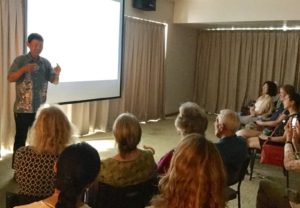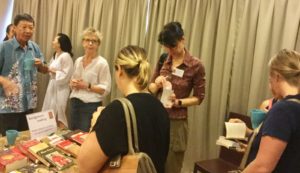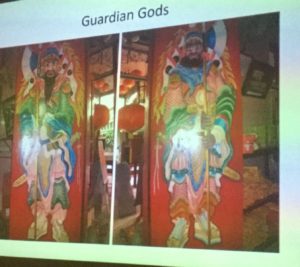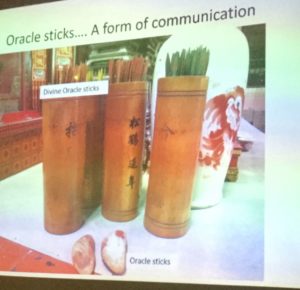The Sin Sze Si Ya Temple, a talk by Billy Woo Yin Khee
on 4th Oct 2017
Billy Woo is a passionate and unassuming tourist guide, who shared the history of the oldest temple in Kuala Lumpur and the still ongoing worship practices. I found it insightful, even after living so many years in this region. What strikes me again is the practicality of the Chinese, even in organising their worship.
Chinese immigrants settled in the 18th century to work in the tin mines. Kapitan Yap Ah Loy (Hakka Chinese like many in the mines) was at the root of transforming swampy KL into a prosperous city. He built the Sin Sze Si Ya Temple in 1864-1882 to honour his boss Kapitan Sheng Ming Li and General Chung Lai. They became local deities under the names Sin Si Ya and Sze Si Ya. Sze means number 4, a practical way to name the fourth born in a family. Si Ya means advisor.
The temple (close to Central market) is a mixture of Taoist, Buddhist and Confucian doctrines. It served not only as a place to worship, but also to help new immigrants, to settle disputes, to register marriages, to offer medical care and provide education in Chinese. The Tung Shin Maternity hospital founded by Kapitan Cina Yap Kwan Seng in 1881 is now a modern facility at Jalan Pudu. Until today the temple donates more than 1 Million Ringgit per year. Twice per year there is a food festival where poor people can come to collect food for themselves and their family. They can choose between vegetarian and roast pork or chicken. The next one is on 20th November.



Chinese are practical in their worship: make it easy for the deities and the devotees, who ask for favours. Deities are focused on specific favours like wealth, smooth delivery, sex of the baby, fame, longevity and bliss, recovery of sickness, education and examination, beauty, protection of husband (to prevent him having an affair). One exception: the Heavenly God in the centre is symbolised by the incense sticks and tables with offerings. Another exception: the popular Buddhist Goddess of Mercy can answer all questions.
Names are displayed with donations e.g. at the base of coil incense, so the Gods will know. Similarly, when you donate, the drum is hit and your name is called. Deities have faces with clear expression to make it easy for worshippers to relate to. Joss sticks are burned, not for the Gods, but for a good feeling of the worshipper. With the smoke the prayers are going up to the Gods.
Worshippers bring food or flowers. When a lady comes to pray for fertility, she will bring coloured flowers. After prayer she will take the flowers and put them in the bedroom.
The White Tiger deity can stop others doing bad things to you. The worshipper slaps a white paper and burns it symbolizing that bad things will not happen.



Lotus shaped candles are revered by Buddhists. The white colour is for the boys and the pink for the girls. The lotus flower is beautiful, and grows well in dirty water. It symbolizes purity in life, even when there are many temptations.
Chinese love to hear from the Gods about their fortune. They use the Divine Oracle Sticks. A bundle is shaken until one stick falls out. The number on the stick refers to a paper in old Chinese. An old lady used to translate it. Now they have made a book with all the translations.
If worshippers want an answer Yes or No for a specific question, they throw 2 half round wooden blocks on the ground. One flat side on the ground, one flat side in the air means Yes. Two flat sides up: no opinion. Two flat sides on the ground: God is not happy, better go home. They can throw three times during one visit. If the result is not good, they can come back later.
The temple does not have a priest, but you can get help to pray. This support was subcontracted out, but that was prone to misuse. Members of the temple community have taken over this role.



Billy has shared much more than what I have written. And I have not shared how the temple looks like. I suggest to go and have a look yourself at 14A, Lebuh Pudu. The entrance is a little hidden. Open from 7am till 5 pm. There is a good brochure at the entrance.
Two lions guard the entrance: one a father with money, the other a mother with a baby. When closed, you will see the guardian gods who keep the evil spirits away.
Alexius Collette
